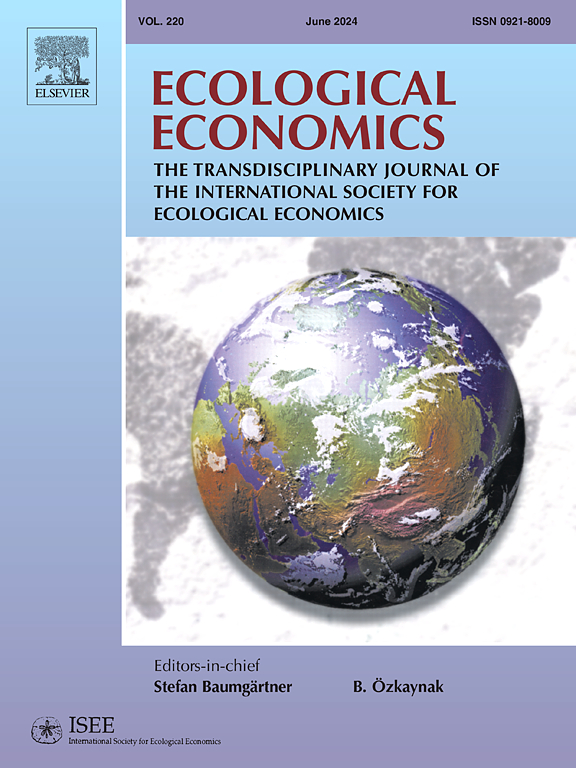Incorporating use values into ecosystem specific accounts: Recreational value generated by saltmarsh at a mixed ecosystem site
IF 6.6
2区 经济学
Q1 ECOLOGY
引用次数: 0
Abstract
The single-site travel cost model is a method typically used to estimate the recreational value of open-access natural areas. However, when utilised at sites where multiple ecosystem types are present, the proportion of value that is generated by each ecosystem can be unclear. Natural capital frameworks, such as the UN's System of Environmental-Economic Accounting, require values that are ecosystem specific. Therefore, recreational values from single-site travel cost models may be difficult to incorporate. In this study, we estimate the use value of a protected coastal site using a single-site travel cost model and demonstrate three approaches that could be employed to assign a proportion of the total use value to one of the key ecosystems at the site, a saltmarsh. The welfare estimate for the entire site is €4.1 million per year. The value that can be attributed to saltmarsh ranges from €280,154 to €1.7 million, depending on the approach used. We discuss the relevance of these approaches for different contexts, including natural capital accounting.
将使用价值纳入生态系统特定账户:一个混合生态系统地点的盐沼产生的娱乐价值
单点旅行成本模型是一种通常用于估算开放式自然区域休闲价值的方法。然而,当在存在多种生态系统类型的地点使用时,每个生态系统产生的价值比例可能并不明确。自然资本框架(如联合国环境经济核算体系)要求具体生态系统的价值。因此,单一地点旅行成本模型中的娱乐价值可能难以纳入。在本研究中,我们使用单点旅行成本模型估算了一个沿海保护区的使用价值,并展示了可用于将总使用价值的一部分分配给该保护区的一个关键生态系统(盐沼)的三种方法。整个地点的福利估计值为每年 410 万欧元。根据不同的方法,盐沼的价值从 280,154 欧元到 170 万欧元不等。我们讨论了这些方法在不同情况下的相关性,包括自然资本核算。
本文章由计算机程序翻译,如有差异,请以英文原文为准。
求助全文
约1分钟内获得全文
求助全文
来源期刊

Ecological Economics
环境科学-环境科学
CiteScore
12.00
自引率
5.70%
发文量
313
审稿时长
6 months
期刊介绍:
Ecological Economics is concerned with extending and integrating the understanding of the interfaces and interplay between "nature''s household" (ecosystems) and "humanity''s household" (the economy). Ecological economics is an interdisciplinary field defined by a set of concrete problems or challenges related to governing economic activity in a way that promotes human well-being, sustainability, and justice. The journal thus emphasizes critical work that draws on and integrates elements of ecological science, economics, and the analysis of values, behaviors, cultural practices, institutional structures, and societal dynamics. The journal is transdisciplinary in spirit and methodologically open, drawing on the insights offered by a variety of intellectual traditions, and appealing to a diverse readership.
Specific research areas covered include: valuation of natural resources, sustainable agriculture and development, ecologically integrated technology, integrated ecologic-economic modelling at scales from local to regional to global, implications of thermodynamics for economics and ecology, renewable resource management and conservation, critical assessments of the basic assumptions underlying current economic and ecological paradigms and the implications of alternative assumptions, economic and ecological consequences of genetically engineered organisms, and gene pool inventory and management, alternative principles for valuing natural wealth, integrating natural resources and environmental services into national income and wealth accounts, methods of implementing efficient environmental policies, case studies of economic-ecologic conflict or harmony, etc. New issues in this area are rapidly emerging and will find a ready forum in Ecological Economics.
 求助内容:
求助内容: 应助结果提醒方式:
应助结果提醒方式:


